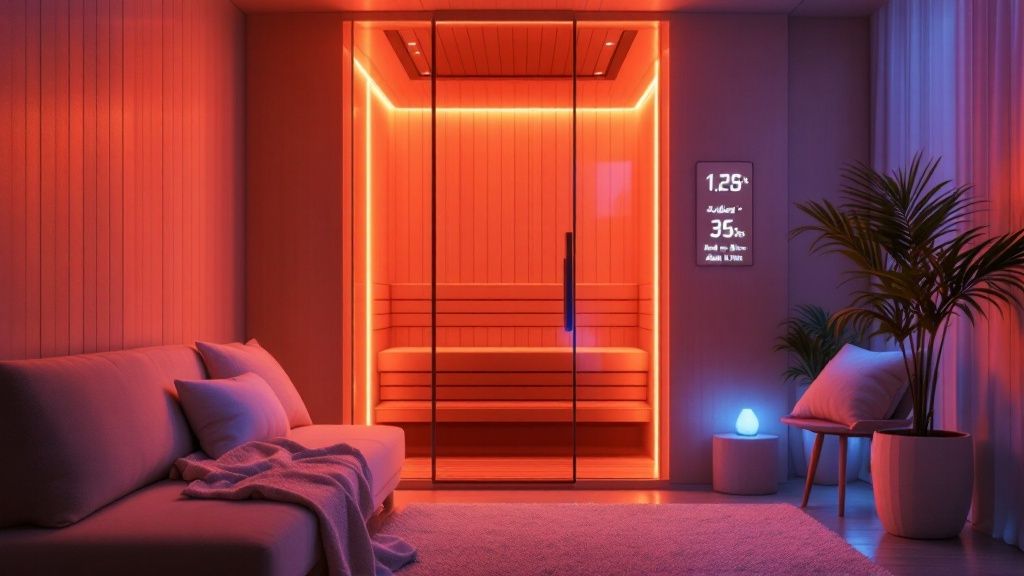Infrared Sauna Calorie Burn: Boost Your Weight Loss
- Sauna Tracker

- Apr 4
- 12 min read
The Science Behind Infrared Sauna Calorie Burn

Infrared saunas offer a distinct approach to heat therapy. They use infrared light wavelengths to penetrate deeper into the body than the heat from traditional saunas. This deeper penetration creates a series of physiological responses. These responses directly affect your metabolic rate and contribute to calorie burn. But how does this process work?
How Infrared Heat Affects the Body
Traditional saunas heat the air around you. Infrared saunas, however, heat your body directly. This direct heating activates your body's natural cooling systems. It's similar to how your body cools down after a light workout.
This cooling process involves an increased heart rate and improved blood circulation. These work together to dissipate the heat. As your heart beats faster to pump blood to the skin's surface, your body expends energy. This contributes to calorie burn.
The increased blood flow also delivers more oxygen and nutrients to your muscles and organs. This boosts cellular activity and further increases your metabolic rate. This elevated metabolic rate continues even after your sauna session, much like the “afterburn effect” after exercise. For more on sauna benefits, check out our sitemap of blog posts.
The Calorie Burning Process in Detail
The calorie burning process in an infrared sauna is linked to your body’s thermoregulation system. As your core temperature increases, your body works harder to maintain a healthy internal temperature. This increased effort burns calories. The exact number of calories burned varies depending on individual factors like age, body weight, and metabolism.
Infrared heat can also stimulate lipolysis. This is the breakdown of stored fat into fatty acids that can be used as fuel. Your body not only burns calories to cool down, but it also uses stored fat for energy. Over time, this increased fat burning can contribute to weight loss. Early discussion of calorie burn in infrared saunas appeared in a 1981 letter to the editor in the Journal of the American Medical Association (JAMA). While initial estimates have been refined, studies now suggest a 30-minute session can burn between 250 to 600 calories, comparable to mild exercise. More detailed statistics can be found here.
The Impact of Infrared Wavelengths
The specific wavelengths of infrared light play a key role in increasing calorie burn compared to conventional heat. Infrared waves penetrate deeper into the body. This causes a more significant rise in core temperature and a greater metabolic response. This deeper penetration also leads to enhanced detoxification through sweating, further supporting overall wellness and potentially indirectly assisting with weight management.
Infrared Sauna vs. Exercise: The Calorie Truth

Let's explore how the calorie burn of an infrared sauna stacks up against traditional exercise. Many people wonder if relaxing in a sauna can truly replace a good workout. This section aims to clarify the relationship between these two activities and set realistic expectations for weight management.
Comparing Calorie Expenditure
How effective are infrared saunas at burning calories? It's comparable to moderate exercise. A 30-minute sauna session can burn between 250 and 400 calories, similar to a light jog or bike ride.
A longer session, say 40 minutes, could burn between 300 and 690 calories, depending on your individual physiology and the sauna's temperature. This makes infrared saunas a potentially useful tool for weight management, alongside diet and exercise.
It's crucial to remember that the initial weight loss after a sauna session is primarily due to water loss through sweating. Learn more about the facts and myths of sauna calorie burn at Crunch.
To illustrate the comparison further, let's look at the following table:
To better understand the caloric expenditure differences, let's take a look at this comparison:
Caloric Expenditure: Infrared Sauna vs. Exercise A comparison of estimated calories burned during various activities compared to infrared sauna sessions of different durations
Activity | Duration | Average Calories Burned | Intensity Level |
|---|---|---|---|
Infrared Sauna | 30 minutes | 250-400 | Low |
Infrared Sauna | 40 minutes | 300-690 | Low |
Light Jogging | 30 minutes | 200-350 | Moderate |
Cycling | 30 minutes | 250-400 | Moderate |
Weight Training | 30 minutes | 200-300 | Moderate to High |
As the table shows, the caloric expenditure of an infrared sauna session can be comparable to common exercises. However, the intensity level remains low, highlighting the different nature of calorie burning in a sauna.
The Complementary Relationship
Infrared saunas and exercise offer distinct advantages. Exercise builds muscle, improves cardiovascular health, and burns calories through physical exertion. Infrared saunas offer passive calorie burning along with benefits like detoxification and improved circulation.
Combining these activities can create a synergistic effect. Infrared saunas can aid post-workout recovery by reducing muscle soreness and promoting relaxation. This can lead to more frequent and intense workouts, resulting in a higher overall calorie burn. Check out our guide on tracking sauna usage for more information.
Finding the Right Balance
While infrared saunas contribute to calorie burning, they are not a replacement for exercise. They are best used as a supplement to an existing fitness routine. The best approach involves a balanced combination of both, tailored to your individual needs and goals. Think of exercise as the foundation for a healthy body, with infrared saunas as a valuable addition to optimize recovery and support your weight management efforts.
Real Results: Weight Loss Success With Infrared Saunas

Many anecdotal stories discuss infrared saunas and weight loss. But what does the clinical research say about how well they really work? This section explores research examining how body composition changes in people who use infrared saunas regularly. We'll look at patterns of success and what leads to positive outcomes.
Analyzing Research Data
Many studies track before-and-after data for people using infrared saunas, giving us helpful information. These studies show how regular sauna use can help reduce body fat percentage over time. They also illuminate how different groups of people respond to infrared sauna therapy.
For instance, a study from Binghamton University showed that participants using an infrared sauna three times a week for 30 minutes saw an average 4% reduction in body fat over four months. This suggests that while infrared saunas won't replace a good workout, they can be a valuable part of a weight loss plan when used consistently. This decrease in body fat was connected to a faster metabolism and detoxification. Learn more about how many calories you can burn in an infrared sauna here. The study also recommends combining sauna use with regular exercise for better weight management and overall health.
Case Studies and Success Factors
Looking at case studies of real users gives us more practical information about using infrared saunas for weight loss. These real-life examples reveal the important factors that separate successful outcomes from less effective experiences. Just using an infrared sauna isn't enough.
Session Consistency: Regular sauna sessions are more effective than using the sauna only occasionally.
Session Duration: The length of each session matters. Longer sessions generally burn more calories.
Timing: When you schedule your sauna sessions in relation to exercise or meals could affect your results.
You might also want to learn more about optimizing sauna usage: How to master your sauna routine
Lifestyle Choices and Infrared Sauna Use
Besides simply using the sauna, other lifestyle choices are important. Staying well-hydrated, eating a balanced diet, and getting regular exercise significantly impact your potential for weight loss with infrared saunas. Even if you use the sauna consistently, neglecting these lifestyle factors can slow your progress.
A Realistic Framework for Weight Loss
Understanding these factors provides a realistic view of what you can achieve with strategic infrared sauna use. It's not a magic solution, but it can be a helpful tool. By incorporating consistent sauna sessions into a healthy lifestyle, you can maximize its potential for weight loss and overall well-being. This means having realistic expectations, keeping track of your progress, and changing your routine as needed.
Maximizing Your Infrared Sauna Calorie Burn Potential

Not all sauna sessions are created equal when it comes to calorie burn. This section explores techniques to boost the metabolic impact of infrared saunas. We'll look at strategies involving temperature, timing, and body position to help you maximize calorie expenditure. Understanding how hydration, nutrition, and recovery practices interact with these techniques is also key to optimizing the metabolic benefits.
Strategic Approaches To Enhance Calorie Burn
Several strategies can significantly impact your calorie burn during an infrared sauna session. These include adjusting the temperature to challenge your body, choosing the optimal timing for your sessions, and even considering your body position within the sauna itself. This active approach means you're not just relaxing but strategically maximizing your body's response to infrared heat.
Temperature Variation: Gradually increasing the temperature throughout your session encourages your body to work harder to maintain its core temperature. This increased effort can result in a greater number of calories burned.
Session Timing: Consider scheduling your sauna sessions after workouts. This approach may extend the post-exercise metabolic boost, maximizing calorie expenditure. Hydration before your sauna session is also important in supporting this process.
Body Positioning: Even small adjustments in body position within the sauna can impact your results. Certain positions may improve circulation and heat exposure, potentially increasing calorie burn.
Many individuals exploring weight loss strategies find helpful resources online. Weighted Vests Weight Loss may be a valuable tool for those seeking more information about weight management techniques.
Hydration, Nutrition, and Recovery
Proper hydration is crucial for maximizing the benefits of infrared saunas and achieving optimal calorie burn. Dehydration can hinder your body's ability to cool down efficiently, limiting calorie expenditure. Therefore, drinking enough water before, during, and after your sauna session is essential.
Pre-sauna nutrition plays a role in maximizing your results. Consuming a light, nutritious meal or snack before your session provides your body with the fuel it needs to effectively manage the heat exposure and optimize the metabolic response. A small portion of complex carbohydrates combined with lean protein can be an ideal pre-sauna snack.
Finally, recovery practices are also essential for supporting your metabolic benefits. Allow your body to cool down gradually after the sauna and focus on replenishing electrolytes lost through sweating. This will ensure your body recovers efficiently and is prepared for future sessions. Check out How to master your sauna routine for more helpful recovery tips.
Progressive Intensity and Complementary Techniques
Gradually increasing the intensity of your sauna sessions—either through longer durations or higher temperatures—over time can further enhance calorie burn. Similar to exercise, progressively challenging your body in the sauna can lead to greater adaptations and improved results.
Incorporating complementary techniques can amplify the effects of your sauna sessions. Contrast therapy, for example, can potentially double your calorie-burning results. This technique involves alternating between hot and cold exposure, such as taking a cold shower immediately after your sauna session. The rapid temperature change stimulates both circulation and metabolic activity, leading to increased calorie burn.
Let's take a closer look at some specific techniques to enhance your infrared sauna experience and maximize calorie burn.
Here's a helpful table summarizing strategies for optimizing calorie burn in an infrared sauna:
Infrared Sauna Calorie Burn Optimization Strategies
Strategy | Implementation | Potential Benefit | Scientific Support Level |
|---|---|---|---|
Temperature Variation | Gradually increase temperature during the session. | Increased thermoregulatory effort leading to higher calorie expenditure. | Moderate |
Session Timing | Schedule sessions post-workout. | Extends post-exercise metabolic boost. | Moderate |
Hydration | Consume adequate fluids before, during, and after the session. | Supports optimal thermoregulation and metabolic function. | High |
Pre-Sauna Nutrition | Consume a light meal with complex carbs and lean protein. | Provides energy for heat exposure and metabolic response. | Moderate |
Body Positioning | Experiment with positions to maximize heat exposure. | May enhance circulation and heat absorption. | Low |
Contrast Therapy | Alternate between hot sauna and cold exposure (e.g., cold shower). | Further stimulates metabolic activity and calorie burning. | Moderate |
Progressive Intensity | Gradually increase session duration or temperature over time. | Leads to greater physiological adaptations and increased calorie burn. | High |
By understanding these techniques and incorporating them into your routine, you can transform your sauna sessions into a powerful tool for boosting your metabolism and achieving your wellness goals.
Beyond Calories: Hidden Benefits Amplifying Weight Loss
While the calorie burn from infrared saunas is a significant benefit, it's only one piece of the puzzle. This section explores the less obvious ways infrared saunas can support your weight loss journey. These often-overlooked benefits work behind the scenes to create a more conducive environment for shedding those extra pounds.
Hormonal Harmony and Reduced Inflammation
Infrared sauna sessions can impact key hormones and inflammatory pathways crucial to how your body stores fat. Consistent infrared heat exposure can improve insulin sensitivity, meaning your body utilizes glucose more effectively, reducing fat storage.
Infrared saunas can also influence your body's stress response. Chronic stress elevates cortisol, a hormone linked to increased abdominal fat. The relaxing heat can help manage stress, promoting hormonal balance favorable to weight loss. Furthermore, infrared heat can reduce inflammation, another factor contributing to weight gain. By addressing these underlying issues, infrared saunas create a more positive internal environment for weight management. You might be interested in: How to master your sauna routine.
Deep Detoxification and Cellular Regeneration
Sweating isn't just about cooling down; it's a powerful detoxification process. Infrared saunas promote deep sweating, eliminating toxins stored in fat cells. This removes metabolic roadblocks that can hinder weight loss.
Moreover, infrared heat promotes cellular regeneration, repairing damaged cells and creating healthy new ones. This renewed cellular environment is more receptive to positive changes associated with weight loss.
Sleep Enhancement and Hunger Hormone Regulation
Quality sleep is vital for weight management, and infrared saunas can improve your sleep patterns. The deep relaxation and heat exposure can improve sleep quality, positively impacting weight loss efforts.
Improved sleep influences hunger hormones like leptin and ghrelin, which regulate appetite. Imbalances can lead to increased cravings and overeating. By promoting better sleep, infrared sauna use indirectly supports healthier hunger hormone regulation, making it easier to maintain a balanced diet.
The Synergistic Effect: Beyond Calorie Calculations
These hidden benefits often explain why people using infrared saunas regularly see weight loss beyond simple calorie calculations. The combined effects of improved hormonal balance, reduced inflammation, enhanced detoxification, and better sleep create a synergistic effect that amplifies weight loss efforts.
While you burn calories during a sauna session, you're also setting the stage for more efficient and sustainable weight loss. This holistic approach, targeting multiple interconnected factors, makes infrared saunas a powerful ally in achieving your weight goals.
Your Customized Infrared Sauna Calorie Burn Blueprint
Building on the knowledge of infrared saunas and calorie burn, this section helps you take control of your wellness journey. We'll turn general understanding into personalized action plans suited to your individual goals, fitness level, and lifestyle. Consider this your personal roadmap to success with infrared sauna therapy.
Building Your Personalized Plan
Just like a fitness routine, your infrared sauna plan should be tailored to your specific needs. This means considering factors like your weight loss goals, your current fitness level, and any lifestyle limitations.
Weight Loss Objectives: Are you aiming for substantial weight loss, or are you primarily using the sauna for other health benefits with weight management as a secondary goal? This will influence the frequency and duration of your sessions.
Fitness Level: If you're new to saunas, starting slow is crucial. Gradually increase session duration and temperature as your body adjusts. If you’re already physically active, you can integrate sauna sessions more aggressively into your routine.
Lifestyle Constraints: Busy schedules, limited sauna access, and fluctuating motivation can all affect your ability to stick to a plan. Be realistic about your limitations and create strategies to overcome them.
Implementation Strategies: From Beginner to Advanced
Progressing through different phases of infrared sauna use allows your body to adapt gradually. Here are some examples of weekly schedules for different levels:
Beginner: Start with two to three sessions per week, 15-20 minutes per session, at a lower temperature. Focus on becoming comfortable with the sauna environment and establishing a consistent routine.
Intermediate: Increase to three to four sessions per week, 25-30 minutes per session, at a moderately higher temperature. Begin incorporating optimization strategies, such as temperature variation.
Advanced: Use the sauna four to five times a week, 30-45 minutes per session, at a higher temperature (always within safe limits). Implement advanced techniques like contrast therapy (alternating hot and cold exposure) and monitor your body’s response.
Integrating Sauna Use With Exercise
Combining infrared sauna sessions with regular exercise can significantly amplify your results. Here’s how you can integrate the two:
Post-Workout Sauna: Enjoy a sauna session after your workout to promote muscle recovery, reduce soreness, and potentially extend the post-exercise metabolic boost.
Pre-Workout Sauna: Some individuals find a brief sauna session before a workout beneficial for warming up muscles and increasing flexibility. However, ensure adequate hydration and avoid overheating.
Rest Days: Incorporate sauna sessions on rest days to maintain metabolic activity and support recovery without stressing your muscles.
Tracking Progress and Overcoming Plateaus
Tracking key metrics helps you understand what's working and identify areas for improvement. This goes beyond simply monitoring weight loss. Focus on multiple indicators:
Body Composition: Track changes in body fat percentage and muscle mass for a more complete picture of your progress.
Energy Levels: Observe how your energy levels fluctuate throughout the day and after sauna sessions. Increased energy can signal a boosted metabolism.
Sleep Quality: Monitor how sauna use affects your sleep. Improved sleep can indirectly contribute to weight loss by regulating hormones.
Adjust your sauna routine as needed to avoid plateaus. If your results stall, try increasing session duration, experimenting with different temperatures, or incorporating new optimization techniques. This flexibility helps you continually challenge your body and optimize your results.
Addressing Common Challenges
Common challenges like time limitations, accessibility issues, and motivation fluctuations can hinder progress. Here are some practical solutions:
Time Limits: Short, high-intensity sauna sessions can be effective. Even 15 minutes can provide benefits.
Accessibility: If regular sauna access is difficult, consider a portable infrared sauna for home use.
Motivation Fluctuations: Find a sauna buddy for accountability or join an online community for support. Set realistic goals and celebrate small wins.
By addressing these challenges, you can ensure your infrared sauna practice becomes sustainable, maximizing calorie burn and overall health benefits. Start tracking your sauna sessions and unlock your wellness potential with Sauna Tracker!

.png)
